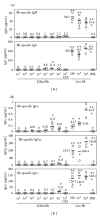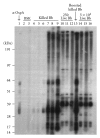ELISA-based measurement of antibody responses and PCR-based detection profiles can distinguish between active infection and early clearance of Borrelia burgdorferi
- PMID: 22110528
- PMCID: PMC3205739
- DOI: 10.1155/2012/138069
ELISA-based measurement of antibody responses and PCR-based detection profiles can distinguish between active infection and early clearance of Borrelia burgdorferi
Abstract
Borrelia burgdorferi is a spirochetal bacterium that causes Lyme disease. These studies address whether current research methods using either ELISA to detect seroconversion to B. burgdorferi antigens or PCR quantification of bacterial DNA within tissues can accurately distinguish between a productive infection versus a B. burgdorferi exposure that is rapidly cleared by the innate responses. Mice receiving even minimal doses of live B. burgdorferi produced significantly more B. burgdorferi-specific IgM and IgG than groups receiving large inocula of heat-killed bacteria. Additionally, sera from mice injected with varied doses of killed B. burgdorferi recognized unique borrelial antigens compared to mice infected with live B. burgdorferi. Intradermal injection of killed B. burgdorferi resulted in rapid DNA clearance from skin, whereas DNA was consistently detected in skin inoculated with viable B. burgdorferi. These data indicate that both ELISA-based serological analyses and PCR-based methods of assessing B. burgdorferi infection clearly distinguish between an established infection with live bacteria and exposure to large numbers of bacteria that are promptly cleared by the innate responses.
Figures



Similar articles
-
Significantly improved accuracy of diagnosis of early Lyme disease by peptide enzyme-linked immunosorbent assay based on the borreliacidal antibody epitope of Borrelia burgdorferi OspC.Clin Vaccine Immunol. 2008 Jun;15(6):981-5. doi: 10.1128/CVI.00079-08. Epub 2008 Apr 16. Clin Vaccine Immunol. 2008. PMID: 18417666 Free PMC article.
-
Predictive value of Borrelia burgdorferi IgG antibody levels in patients referred to a tertiary Lyme centre.Ticks Tick Borne Dis. 2018 Mar;9(3):594-597. doi: 10.1016/j.ttbdis.2017.12.014. Epub 2017 Dec 24. Ticks Tick Borne Dis. 2018. PMID: 29422448
-
Enzyme-linked immunosorbent assay, immunofluorescent assay, and recombinant immunoblotting in the serodiagnosis of early Lyme borreliosis.Int J Immunopathol Pharmacol. 2003 Sep-Dec;16(3):261-8. doi: 10.1177/039463200301600312. Int J Immunopathol Pharmacol. 2003. PMID: 14611730
-
Laboratory testing for suspected Lyme disease.Med Clin North Am. 2002 Mar;86(2):311-40. doi: 10.1016/s0025-7125(03)00089-0. Med Clin North Am. 2002. PMID: 11982304 Review.
-
Lyme disease: laboratory issues.Infect Dis Clin North Am. 2008 Jun;22(2):301-13, vii. doi: 10.1016/j.idc.2007.12.005. Infect Dis Clin North Am. 2008. PMID: 18452803 Review.
Cited by
-
Persistent Borrelia Infection in Patients with Ongoing Symptoms of Lyme Disease.Healthcare (Basel). 2018 Apr 14;6(2):33. doi: 10.3390/healthcare6020033. Healthcare (Basel). 2018. PMID: 29662016 Free PMC article.
-
The Long-Term Persistence of Borrelia burgdorferi Antigens and DNA in the Tissues of a Patient with Lyme Disease.Antibiotics (Basel). 2019 Oct 11;8(4):183. doi: 10.3390/antibiotics8040183. Antibiotics (Basel). 2019. PMID: 31614557 Free PMC article.
-
Generality of Post-Antimicrobial Treatment Persistence of Borrelia burgdorferi Strains N40 and B31 in Genetically Susceptible and Resistant Mouse Strains.Infect Immun. 2019 Sep 19;87(10):e00442-19. doi: 10.1128/IAI.00442-19. Print 2019 Oct. Infect Immun. 2019. PMID: 31308087 Free PMC article.
-
Statins reduce spirochetal burden and modulate immune responses in the C3H/HeN mouse model of Lyme disease.Microbes Infect. 2016 Jun;18(6):430-435. doi: 10.1016/j.micinf.2016.03.004. Epub 2016 Mar 16. Microbes Infect. 2016. PMID: 26993029 Free PMC article.
-
Late Disseminated Lyme Disease: Associated Pathology and Spirochete Persistence Posttreatment in Rhesus Macaques.Am J Pathol. 2018 Mar;188(3):672-682. doi: 10.1016/j.ajpath.2017.11.005. Epub 2017 Dec 12. Am J Pathol. 2018. PMID: 29242055 Free PMC article.
References
Publication types
MeSH terms
Substances
Grants and funding
LinkOut - more resources
Full Text Sources
Medical
